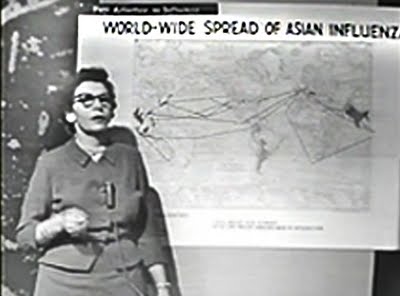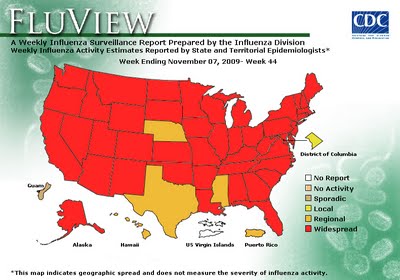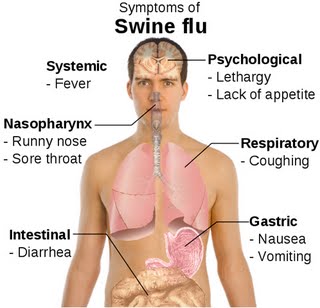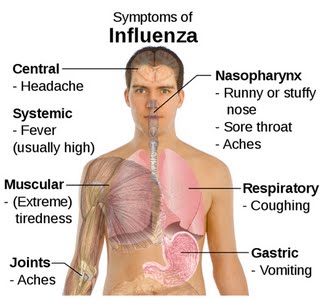While H1N1 is now officially the first pandemic of the 21st Century, it’s not the first Pandemic to strike in recent history. Today, we’re going to take a look back at three flu pandemics of the 20th century – the “Spanish Flu,” the “Asian flu” and the “Hong Kong Flu.”
 SPANISH FLU – 1918
SPANISH FLU – 1918I think the quickest way to get you up to speed on the general, “vibe” of the Spanish flu, is that it has been described as the, “WORST MEDICAL HOLOCAUST IN HISTORY.” The 1918 Flu pandemic spread to almost every part of the world—even remote pacific islands and the arctic had cases of the disease. Between March 1918 and June 1920, Spanish flu killed anywhere from 50 to 100 MILLION people worldwide. To put this into perspective, that is three to seven times the amount of people killed in WWI, or 3-6% of the world population. One-third of the world population (500 million people) was infected with disease.
If widespread infection and a death toll that surpassed that from a WORLD WAR wasn’t enough, Spanish flu had a few more horrible tricks up its sleeve. Spanish flu greatly weakened the immune system, allowing bacterial pneumonia to creep in and kill those who were infected. The virus itself also took many lives, as it cause massive hemmorages and edema in the lungs. This led to people bleeding to death via hemmorages in the stomach, intestines, lungs, ears, and skin. Talk about a HORRIBLE way to die!
Spanish flu was first recorded in the United States, and quickly spread to Europe. So why isn’t Spanish Flu called United States Flu? Spain was neutral during WWI, so they had no censorship on information about the disease, its effects, and how to treat it. Therefore Span gave the most legitimate and reliable news n the pandemic, and in the process gave a false impression that Spain was the most or only country affected.
Spanish Flu spread quickly with help from WWI. Soldiers were kept in close quarters in cold, wet trenches. They were also exposed to chemical weapons, stress, and were frequently malnourished, leaving them with weakened immune systems. Another reason the disease was so brutal, was that modern transportation was available during a pandemic for the first time, greatly increasing the worldwide spread of the disease. Finally, the lack of true modern medicine meant that Spanish Flu was frequently misdiagnosed as dengue, cholera, or typhoid, and therefore was not properly treated.
Noo ne is completely sure how the Spanish Flu virus came to infect humans. Some researchers believe it may have jumped from a mammal to humans, but most believe it to be a type of Avian flu.
 ASIAN FLU – 1957
ASIAN FLU – 1957Asian Flu was a type of Avian Influenza that originated in China. The Pandemic lasted from 1956-1958. A Asian flu jumped from wild ducks to human beings via a genetic mutation. The flu spread throughout china and parts of Asia in 1956, and made its way to the United States in June 1957.
According to the World Health Organization, Asian flu killed 2 million people worldwide, and 69,800 in the US. Due to scientific advancements science 1918, the Asian flu virus was quickly identified, and a vaccine was developed within a year of its discovery.
 HONG KONG FLU – 1968
HONG KONG FLU – 1968July 1968 marked the first recorded outbreak of Hong Kong Flu. By the end of the month, the virus had already spread to Vietnam and Singapore. The Hong Kong Flu virus evolved directly from the Asian Flu virus, and despite the similarity between the two viruses, little improvements had been made in how to handle a flu pandemic.
The Hong Kong flu made it to the United States in September 1968, brought home by returning Vietnam War troops. The disease became widespread in America by December 1968, and by 1969 the disease had made it to Japan, Africa, and South America.
Compared to the Spanish and Asian flu, the Hong Kong flu had a low mortality rate. Only 0.5% of those infected died. Hong Kong flu killed 1 million people worldwide, with 33,800 of those people being American.
Besides improved medical and scientific advancements, another reason that the Hong Kong Flu was not as deadly was that many people were partially vaccinated before it even existed. Since the Hong Kong flu evolved directly from the Asian Flu, anyone who contracted the Asian Flu had a significant immunity to the Hong Kong Flu.
SO – while H1N1 could almost never be as bad as the 1918 Spanish Flu, it’s still a very serious disease. One of the main reasons that H1N1 is not as deadly as the Spanish Flu is that we now have improved antibiotics, vaccines, and plans to follow to stop pandemics in their tracks. Remember – you are the first line of defense against the spread of H1N1. If you’re sick: STAY HOME! Wash your hand frequently, and always cough into a tissue or your bent elbow.
Furthermore, if you are a teacher or business owner who believes that H1N1 may be present in your property, do the right thing: Call Bio-Clean of New Jersey. As the years passed during the 20th Century, flu pandemics became less and less deadly – But that’s only because scientific advancements got better. Bio-Clean uses a cutting edge, broad spectrum disinfectant and dispersal system to statistically lower you and your employee’s risk of infection. Check it out on our website! Don’t risk having sick employees or having to close your business- Call Bio-Clean of New Jersey today and ask about the scientific advancements in Flu Decontamination.
Labels: flu, H1N1, H1N1 decontamination, Pandemics, seasonal flu

State health officials yesterday announced six adults died from the swine flu in nine days this month.
The recent string of deaths does not mean the swine flu, or H1N1 flu as it is also known, has evolved into a more deadly virus, said Deputy Health and Senior Services Commissioner Susan Walsh. Most who contract the illness miss some school or work but recover quickly without a hospital stay.
But the illness has now been reported in every county since the initial outbreak in April, so people should take precautions, Walsh said.
"It is important that everyone remember the public health measures that can reduce the chances of contracting the disease Ð get vaccinated against H1N1, wash your hands frequently, cover your cough and stay home when you're sick," Walsh said.
The swine flu has killed 28 New Jerseyans since April. However only two were children, bucking a national trend.
"The main point is the (outbreak) is so unpredictable, nothing surprises me," said state Health Commissioner Heather Howard.
The six who died this month had underlying medical conditions such as asthma, diabetes and obesity, Walsh said. They are: a 24-year-old Passaic County man who died Nov. 2; a 30-year-old Passaic County man who died Nov. 5; a 36-year-old Burlington County woman who died Nov. 6; a 42-year-old Somerset County woman who died Nov. 7; a 42-year-old Burlington County woman who died Nov. 8; and a 33-year-old Ocean County woman who died Nov. 11.
Walsh used the announcement to publicize telephone and online resources to help people locate the vaccine, which is in short supply. Today, the state is expected to submit new orders for certain forms of the vaccine Ð a sign back orders are clearing, said state health department spokeswoman Donna Leusner.
Google Inc. has launched a flu shot finder with the locations of clinics that offer seasonal and H1N1 vaccines, Walsh said. The link is available at www.google.com/flushot and the department's Web site at http://nj.gov/health/flu/h1n1.shtml. State residents may call New Jersey's H1N1 Information Hotline, (866) 321-9571, from 9 a.m. to 5 p.m. seven days a week.
Labels: flu, H1N1, H1N1 decontamination, seasonal flu
Although the majority of the nation knows a little more about the flu than their grandmother did, there’s still a lot of room for confusion. Cable news flu coverage is simultaneously chock full of specific terminology and vague medical terms. It can get confusing quick! Here’s a little fact sheet to help clear the haze:
EPIDEMIC – The rapid spread of a disease that affects some or many people in a community or region at the same time. (Spreads quickly, effects locally)
PANDEMIC – An outbreak of a disease that affects large numbers of people throughout the world and spreads rapidly. (Spreads quickly, effects globally)
INFLUENZA A – Flue viruses are broken down into three divisions; Influenza A, Influenza B, and Influenza C. Influenza A strains appear in several types of animals, including human. Yes, along with Bird and Swine Flu, there is a Human Flu. Human Flu in humans is the typical seasonal flu that comes around every year. It’s bad, but manageable. The problem with Influenza A viruses arise when animal strains mutate and/or transfer over into the human population.
 H5N1 – “Avian Flu/ Bird Flu” H5N1 is a strain of Influenza A that usually effects only birds. The virus can cause epidemics in bird populations, decimating entire poultry farms. 1997, a Hong Kong boy was the first human to be effected by H5N1. An outbreak that began in 2003 has infected over 250 people in 10 countries. More than half of them have died, demonstrating just how deadly H5N1 is to humans.
H5N1 – “Avian Flu/ Bird Flu” H5N1 is a strain of Influenza A that usually effects only birds. The virus can cause epidemics in bird populations, decimating entire poultry farms. 1997, a Hong Kong boy was the first human to be effected by H5N1. An outbreak that began in 2003 has infected over 250 people in 10 countries. More than half of them have died, demonstrating just how deadly H5N1 is to humans.As of now, H5N1 can only be spread from infected birds to humans, not from humans to other humans. However, H5N1 mutates and changes very rapidly, so it has a high potentiality of mutating into a virus that can be spread from human to human.

H1N1 – “Swine Flu” H1N1 is like H5N1 in that they are both Influenza A strains that originated in non-human animals, but is unlike H5N1 in that it is now easily communicable between humans.H5N1 was first detected in its human-human state in April 2009. On June 11th 2009, the World Health Organization signaled that a pandemic of H1N1 was underway. There is now an H1N1 flu shot, but supplies are still limited. In order to help control this pandemic, those who suspect they may have H1N1 should stay home, and contact a doctor.
INFLUENZA B – Unlink Influenza A which effects a variety of different animals, Influenza B affects only humans and seals (weird, right?). Because Influenza B has been around plaguing humans for ages, we know how to combat it.

SEASONAL FLU - The good old fashioned flu you grew up with. “A contagious respiratory illness cause by Influenza (flu) viruses occurring every year. It affects an average of 5 to 20 percent of the US population by causing mild to severe illness, and in some instances can lead to death. Adults may be able to infect others 1 day before getting symptoms and as long as 5 days after getting sick.” Different strains of Human Influenza A and Influenza B are what give us the seasonal flu we know and love… or hate. The seasonal flu shot contains weakened strains of both Influenza A and Human Influenza B.
Well, I hope that my explanations of these flu terms will help you get a better understanding of the flu—A key part of staying healthy.
Labels: American Red Cross, disease, flu, H1N1, h5n1, seasonal flu
